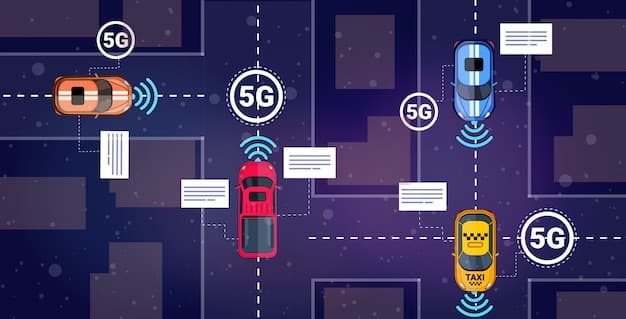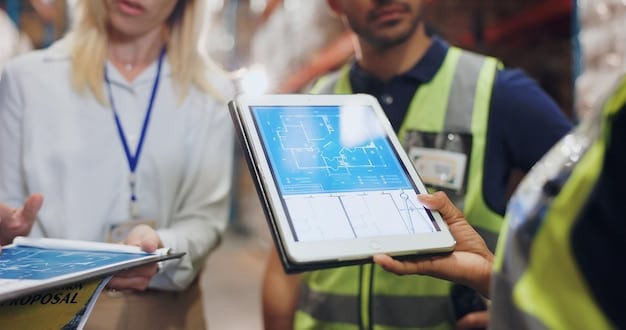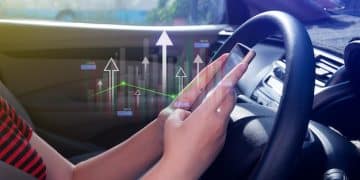Vehicle-to-Everything (V2X): Reducing Accidents by 20%

Vehicle-to-Everything (V2X) communication is a revolutionary technology poised to significantly reduce traffic accidents by enabling vehicles to communicate with each other and their surroundings, creating a safer and more efficient transportation ecosystem.
Imagine a world where cars anticipate accidents before they happen. That’s the promise of Vehicle-to-Everything (V2X) communication: How Will It Reduce Accidents by 20%?.
Understanding Vehicle-to-Everything (V2X) Communication
Vehicle-to-Everything (V2X) communication is more than just a buzzword; it’s a transformative technology designed to enhance road safety and traffic efficiency. By enabling vehicles to “talk” to each other and their environment, V2X has the potential to drastically reduce accidents and improve the overall driving experience.
This section will delve into the core principles of V2X, exploring its various components and how they work together to create a safer, smarter transportation system.
The Core Components of V2X
V2X communication relies on several key components that work in synergy to facilitate data exchange and enhance situational awareness. These components include:
- Vehicle-to-Vehicle (V2V): Allows vehicles to communicate directly with each other, sharing information about speed, location, and potential hazards.
- Vehicle-to-Infrastructure (V2I): Enables vehicles to communicate with roadside infrastructure, such as traffic signals, road sensors, and emergency services.
- Vehicle-to-Pedestrian (V2P): Connects vehicles with pedestrians and cyclists, alerting drivers to the presence of vulnerable road users.
- Vehicle-to-Network (V2N): Facilitates communication between vehicles and cloud-based services, providing real-time traffic updates, navigation assistance, and over-the-air software updates.
Each of these components plays a vital role in creating a comprehensive communication network that enhances road safety and efficiency.

In conclusion, understanding the core components of V2X is crucial to appreciating its potential impact on road safety and traffic management. By connecting vehicles with each other and their surroundings, V2X paves the way for a future of safer, smarter transportation.
How V2X Technology Prevents Accidents
The primary goal of V2X technology is to prevent accidents by providing drivers with real-time information about potential hazards and dangerous situations. By leveraging the power of wireless communication, V2X can significantly enhance situational awareness and enable drivers to make more informed decisions.
This section will explore the various ways in which V2X technology helps to prevent accidents, focusing on specific scenarios and real-world applications.
Real-Time Hazard Warnings
One of the most significant benefits of V2X is its ability to provide drivers with real-time warnings about potential hazards, such as:
- Collision Warnings: Alerts drivers to the risk of a collision with another vehicle, pedestrian, or object in the roadway.
- Emergency Vehicle Alerts: Notifies drivers of approaching emergency vehicles, allowing them to take appropriate action.
- Road Condition Warnings: Informs drivers about hazardous road conditions, such as ice, snow, or standing water.
These real-time warnings provide drivers with crucial information that can help them avoid accidents and stay safe on the road.
To summarize, V2X technology prevents accidents by empowering drivers with information, enabling them to react proactively to dangerous situations and avoid potentially life-threatening collisions.
The Potential for a 20% Reduction in Accidents
The ambitious goal of reducing accidents by 20% through the widespread adoption of V2X technology is based on studies and simulations that demonstrate its effectiveness in preventing collisions. While the exact figure may vary depending on factors such as traffic density and road conditions, the potential for significant accident reduction is undeniable.
This section will delve into the evidence supporting the claim that V2X can reduce accidents by 20%, examining the research and data that underpin this optimistic projection.
Studies and Simulations
Numerous studies and simulations have been conducted to assess the impact of V2X technology on road safety. These studies have consistently shown that V2X has the potential to significantly reduce accidents, particularly:
One study by the National Highway Traffic Safety Administration (NHTSA) found that V2V communication could prevent up to 80% of crashes involving unimpaired drivers.
Although a 20% reduction target is ambitious, it reflects the technology’s potential to transform road safety. Ongoing deployments and data collection will be crucial for validating these projections and optimizing V2X systems for maximum impact.
Challenges and Obstacles to V2X Adoption
While the potential benefits of V2X technology are clear, there are several challenges and obstacles that must be overcome to ensure its widespread adoption. These challenges include:
- Regulatory Hurdles: The lack of clear regulatory guidelines and standards can hinder the deployment of V2X technology.
- Cybersecurity Concerns: Ensuring the security of V2X communication networks is crucial to prevent hacking and data breaches.
- Infrastructure Costs: Deploying the necessary infrastructure to support V2X communication can be expensive and time-consuming.
Addressing these challenges will require collaboration between government agencies, industry stakeholders, and technology developers.
To conclude, addressing the challenges to V2X adoption is crucial for realizing its full potential to save lives and improve road safety.
The Role of Government and Industry in V2X Implementation
The successful implementation of V2X technology will require a collaborative effort between government agencies and industry stakeholders. Government agencies play a crucial role in setting standards, developing regulations, and providing funding for V2X projects.
This section will explore the specific roles that government and industry must play to ensure the widespread deployment of V2X technology.
Government Initiatives
Government agencies can support V2X implementation through initiatives such as:
- Funding Research and Development: Investing in research and development to improve V2X technology and address technical challenges.
- Developing Regulatory Frameworks: Defining clear regulatory guidelines and standards to ensure interoperability and safety.
- Providing Incentives for Adoption: Offering tax breaks or subsidies to encourage manufacturers and consumers to adopt V2X technology.
By taking these steps, government agencies can create a supportive environment for V2X innovation and deployment.

In summary, government and industry must work together to create a roadmap for V2X implementation that addresses regulatory hurdles, promotes technological advancements, and ensures that V2X benefits are available to all drivers.
The Future of V2X: Beyond Accident Reduction
While accident reduction is a primary focus of V2X technology, its potential extends far beyond this single application. V2X can also be used to improve traffic flow, reduce congestion, and enhance the overall driving experience.
This section will explore the future applications of V2X, highlighting its potential to transform transportation and create a more sustainable, efficient, and enjoyable driving experience.
Enhanced Traffic Management
V2X can be used to optimize traffic flow by:
- Dynamic Traffic Light Control: Adjusting traffic light timings in real-time based on traffic conditions.
- Adaptive Cruise Control: Maintaining a safe following distance and adjusting speed based on surrounding traffic.
- Cooperative Lane Changes: Coordinating lane changes between vehicles to reduce congestion.
These enhancements can significantly improve traffic flow and reduce travel times.
Ultimately, the future of V2X is bright, with the potential to transform transportation in ways we can only begin to imagine. By connecting vehicles with each other and their environment, V2X can create a safer, more efficient, and more enjoyable driving experience for everyone.
| Key Point | Brief Description |
|---|---|
| 🚗 V2V Communication | Vehicles share data for collision avoidance. |
| 🚦 V2I Communication | Vehicles interact with infrastructure (traffic lights). |
| ⚠️ Hazard Warnings | Real-time alerts for road conditions and emergencies. |
| 🛡️ Accident Reduction | V2X aims for a 20% decrease in accidents. |
Frequently Asked Questions (FAQ)
▼
The main goal of V2X communication is to enhance road safety by enabling vehicles to communicate with each other and their surroundings, providing real-time information to drivers.
▼
V2V communication allows vehicles to share data like speed and location, enabling early warnings of potential collisions and helping drivers avoid accidents proactively.
▼
Key challenges include regulatory hurdles, cybersecurity concerns, and the high costs associated with deploying the necessary infrastructure to support V2X communication.
▼
The successful implementation of V2X requires a collaborative effort between government agencies, industry stakeholders, and technology developers to overcome challenges and create standards.
▼
Beyond safety, V2X can improve traffic flow, reduce congestion, and enhance the overall driving experience by optimizing traffic light timings and coordinating lane changes.
Conclusion
In conclusion, Vehicle-to-Everything (V2X) communication holds immense promise for revolutionizing road safety and traffic management. While challenges exist, the potential benefits of reducing accidents and improving transportation efficiency make V2X a critical area for continued investment and development.





